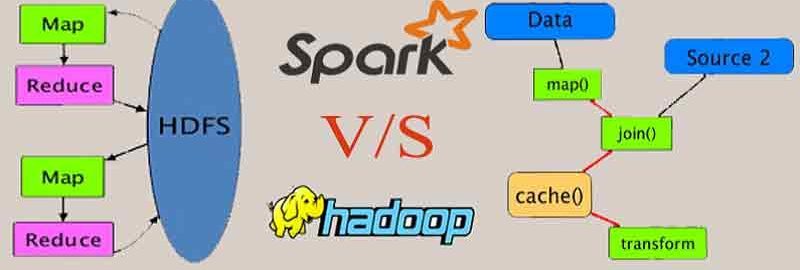
With the passage of time, an increase in distributed networks in the market has been witnessed on account to control an enormous amount of data, speed, and variety. Out of those systems, Spark and Hadoop are the ones that are continuing to attain the most mind share. However, how a person would decide to choose one? Hadoop and Spark are working with each other with the Spark processing data – which is sittings in the H-D-F-S, Hadoop’s file – system. Though they’re different and dispersed objects, and both of them have their advantages and disadvantages along with precise business-use settings.
Hadoop is an open-source model that is enabling to process and keep big data in a dispersed environment throughout the clusters of processors. Hadoop is aimed at scaling up from alone server to numerous machines, where each machine offers local storing and computation. Spark is an open-source cluster computing that is aimed at quick computation. It is providing an interface for encoding the whole cluster with implied fault tolerance and data parallelism. The topmost characteristic of Spark is in-memory cluster computing – which upsurges the velocity of an app.
Hadoop
Hadoop is considered a kind of Apache trademark on a software basis. It is using the simplest software design model account to keep performing the compulsory operation with the clusters. However, the entire modules in Hadoop certifications are aimed at the ultimate notion that failures in hardware are quite usual rates, and it must be deal with by framework.
It is running the app by making use of the Map-Reduce algorithm, as data is handled in parallel on dissimilar kinds of CPU nodes. On the other side, the model of Hadoop can generate apps, that is furthermore able to run on the clusters of computers, and they might perform whole arithmetical analysis for an enormous volume of data.
The main function of Hadoop is based on a storing part that is identified as Hadoop Distributed – File – System and a part of processing known as Map-Reduce software design framework. Hadoop is generally splitting the files into huge blocks and distributing them throughout the clusters, and then convey packages code in nodes on account to practice data in a parallel way.
Spark
Spark has generated on the topmost of the Hadoop – Map-Reduce framework, and it is extending the model of Map-Reduce to effectively using more kinds of computations that are including Stream Processing and Interactive Queries. Spark was initiated by Apache – software foundation, by speeding up Hadoop computational – computing software procedure.
Spark attains its cluster management, and it’s an improved form of the Hadoop. Spark uses Hadoop in these two ways – leading is storing while another one is handling. In the meantime, cluster management arrives from the Spark; it is making use of Hadoop for only storing purposes.
Spark is also the sub-project of Hadoop that was initiated in the year 2009 and after that, it turns out to be open-source under a B-S-D license. It is attaining so many characteristics, by adapting specific modules and integrating the newest modules. It also assists in keeping running apps in the Hadoop cluster, which runs much quicker in the memory.
Hadoop and Spark – Key Differences
Both Hadoop and Spark are most of the renowned choice of selection within the market; let’s highlight a few of the main differences between these two:
- Hadoop is the open-source model that is making use of the Map-Reduce algorithm – while Spark is the computing tech of quick clusters that is extending the Map-Reduce framework to proficiently using with further kinds of the computations.
- The model of Hadoop’s Map-Reduce is reading and writing from disk, therefore, it also slowing down the speed of processing while Spark minimizes the number of reading and writing procedures to disk and storing middle data in memory, therefore, the quick speed of processing.
- Hadoop is requiring the designers to hand over coding – while Spark is easier to do programming with the Resilient – Distributed – Dataset (RDD).
- Hadoop Map-Reduce framework is offering batch-engine, therefore, it is relying on other engines for different requirements while Spark is performing interactive, batch, ML, and flowing all within a similar cluster.
- Hadoop is aimed to manage batch processing effectively, Spark – is aimed to manage actual-time data efficiently.
- Hadoop is an extremely potential computing model that is not having a collaborative mode while Spark is low potential computing, and it would process data interactively.
- By having a Hadoop – Map-Reduce, a designer would only be processing the data in a batch mode simply; however, Spark would process the actual time data via Spark Streaming.
- Hadoop is aimed to manage failures and errors, it’s naturally tough to handle the errors, and therefore it extremely faults tolerant network while, along with the Spark, R-D-D is allowing recovery of barriers on the unsuccessful nodes.
- Hadoop is such a kind of inexpensive opportunity that is accessible, whereas comparing it in the context of budgeting – while Spark is requiring so many RAM on account to running in memory, therefore enhancing the cluster and thus the cost too.
Using Hadoop and Spark Together
There are a lot of examples where a person wants to make use of the two tools at the same time. Regardless of inquiring that in case Spark would substitute Hadoop; they are supposed to complement each other instead of competing it.
Companies that require stream-analysis and batch-analysis for several other facilities would experience the advantages of utilizing both of the tools. Hadoop would deal with massive operations at the minimum price, whereas Spark is processing further small jobs that require prompt development.
Which One Is Better?
To select which one is better is depends on basic parameters – your necessities. Apache Spark is quite a progressive cluster-computing engine as compared to Hadoop’s – Map-Reduce because it would manage any kind of the prerequisite just like streaming, iterative, interactive, batch, etc. whereas, Hadoop is restricting to the process of batch only. On the other side, Spark is pricier as compared to Hadoop in the context of in-memory characteristics that – in return, needs lots of RAM. At last, it is all relying on the budget of the business, as well as a functional necessity.





